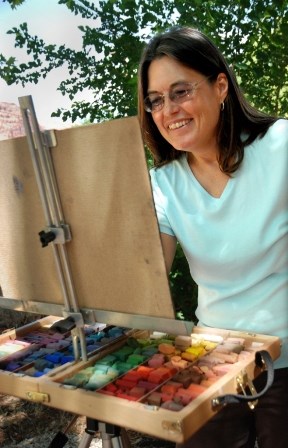
You set up a second sandwich board at the trailhead, indicating where visitors can find you along the trail (e.g. "at the arch"). Once on site, you find a vantage point that gives you what you need for a great piece of art, but isn't in the way of the visitor experience (such as getting the "classic" photograph, reading signs, etc.) or causes any damage to plants or soils. You greet visitors who approach, letting them know what you are up to and inviting them to ask questions. You keep your work area tidy, but approachable -- making it clear that you are the Community Artist in the Parks and you are "open for business." While creating, your goal is to facilitate the visitor's ability to view this special place through an artistic lens. This means being comfortable having conversations while you work. Visitors' questions range from "What are you doing?" to "Why did you chose blue there and not green?" and of course, "Where is the nearest bathroom?" You explain your artistic process and what about this place inspires you. At the same time, you encourage visitors to share their inspiration with you – which often means asking them good questions, like "What do you find inspiring about this place?" and "How do you share it with others?" If asked, you might provide basic information regarding the flora, fauna, geography, geology of the park (some of which you learned at training), as well as directions to other park locations (adhering to any and all park regulations). You finish up your artwork at the scheduled time, pack up your kit and sandwich board (leaving no trace), and drive to the VC. Next, as previously scheduled, you set up a table in front of the Canyonlands Natural History Association store to show the day's work and continue engaging visitors in conversation. While sales are a part of the program, your primary focus is the connection between parks, people, and art. When your shift is over, you take down the visitor center sandwich board, record your time and contact stats (before you forget them), and head home for the day. |
Last updated: April 18, 2025
